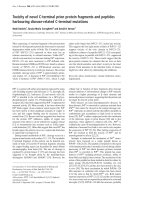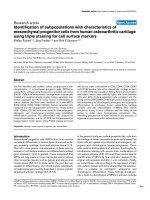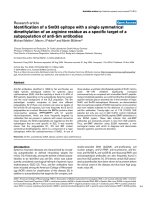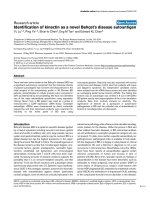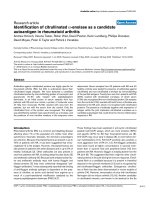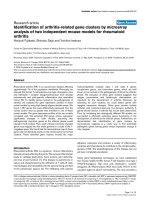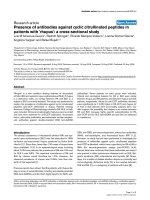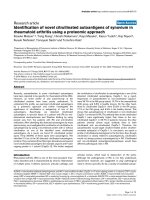Báo cáo y học: "Identification of novel genetic susceptibility loci for Behçet''''s disease using a genome-wide association study" pps
Bạn đang xem bản rút gọn của tài liệu. Xem và tải ngay bản đầy đủ của tài liệu tại đây (102.11 KB, 7 trang )
Open Access
Available online />Page 1 of 7
(page number not for citation purposes)
Vol 11 No 3
Research article
Identification of novel genetic susceptibility loci for Behçet's
disease using a genome-wide association study
Yiping Fei
1,2
, Ryan Webb
2,3
, Beth L Cobb
2,4
, Haner Direskeneli
5
, Güher Saruhan-Direskeneli
6
and
Amr H Sawalha
1,2,7
1
Department of Medicine, University of Oklahoma Health Sciences Center, 825 NE 13th Street, Oklahoma City, OK 73104, USA
2
Arthritis & Immunology Program, Oklahoma Medical Research Foundation, 825 NE 13th Street, Oklahoma City, OK 73104, USA
3
College of Public Health, University of Oklahoma Health Sciences Center, 825 NE 13th Street, Oklahoma City, OK 73104, USA
4
JK Autoimmunity Inc., 755 Research Parkway, Oklahoma City, OK 73104, USA
5
Division of Rheumatology, Department of Internal Medicine, Marmara University Medical School, Tophanelioglu Cad. 13/15, 34662, Uskudar,
Istanbul, Turkey
6
Department of Physiology, Istanbul Faculty of Medicine, Istanbul University, Capa 34093, Istanbul, Turkey
7
US Department of Veterans Affairs Medical Center, 921 NE 13th Street, Oklahoma City, OK 73104, USA
Corresponding author: Amr H Sawalha,
Received: 31 Mar 2009 Revisions requested: 28 Apr 2009 Revisions received: 3 May 2009 Accepted: 14 May 2009 Published: 14 May 2009
Arthritis Research & Therapy 2009, 11:R66 (doi:10.1186/ar2695)
This article is online at: />© 2009 Fei et al.; licensee BioMed Central Ltd.
This is an open access article distributed under the terms of the Creative Commons Attribution License ( />),
which permits unrestricted use, distribution, and reproduction in any medium, provided the original work is properly cited.
Abstract
Introduction Behçet's disease is a chronic systemic
inflammatory disease that remains incompletely understood.
Herein, we perform the first genome-wide association study in
Behçet's disease.
Methods Using DNA pooling technology and the Affymetrix
500K arrays, we identified possible candidate gene
associations with Behçet's disease in a cohort of 152 Behçet's
disease patients and 172 healthy ethnically matched controls.
Genetic loci that were identified in the pooling study were
genotyped in patients and controls using TaqMan genotyping
technology.
Results We identified genetic associations between Behçet's
disease and single-nucleotide polymorphisms (SNPs) in
KIAA1529, CPVL, LOC100129342, UBASH3B, and UBAC2
(odds ratio = 2.04, 2.26, 1.84, 1.71, and 1.61, respectively; P
value = 4.2 × 10
-5
, 1.0 × 10
-4
, 3.0 × 10
-4
, 1.5 × 10
-3
, and 5.8 ×
10
-3
, respectively). Among the associated SNPs, the Behçet's
disease-risk allele in rs2061634 leads to substitution of serine
to cysteine at amino acid position 995 (S995C) in the
KIAA1529 protein.
Conclusions Using an unbiased whole-genome genetic
association approach, we identified novel candidate genetic loci
that are associated with increased susceptibility for Behçet's
disease. These findings will help to better understand the
pathogenesis of Behçet's disease and identify novel targets for
therapeutic intervention.
Introduction
Behçet's disease is a chronic relapsing systemic inflammatory
disease characterized by the presence of oro-genital ulcers,
cutaneous manifestations, and uveitis. The disease can also
lead to vascular complications such as arterial and venous
thrombosis, central nervous system vasculitis, arthritis, and
gastrointestinal involvement [1]. The etiology of Behçet's dis-
ease is not fully understood. Therefore, treatment remains
insufficient and relies on non-specific immunosuppressive
medications, with significant side effects. Evidence for a
genetic contribution to the pathogenesis of the disease comes
from strong familial aggregation, the strong predominance in
patients with Mediterranean or Asian ancestry, and the con-
firmed association with HLA-B51 in several ethnic groups [2-
4].
It is estimated that the association with HLA-B51 in Behçet's
disease accounts for only ~20% of the relative risk in siblings
CI: confidence interval; CPVL: carboxypeptidase, vitellogenic-like; HWE: Hardy-Weinberg equilibrium; OR: odds ratio; SD: standard deviation; SNP:
single-nucleotide polymorphism; UBA: ubiquitin-associated domain; UBAC2: ubiquitin-associated domain containing 2; UBASH3A: ubiquitin asso-
ciated and SH3 domain containing, A; UBASH3B: ubiquitin associated and SH3 domain containing, B.
Arthritis Research & Therapy Vol 11 No 3 Fei et al.
Page 2 of 7
(page number not for citation purposes)
of affected individuals [1]. This suggests that other genetic
elements outside the HLA region carry risk for developing
Behçet's disease. Indeed, a genetic linkage study in a cohort
of Behçet's disease multiplex families identified evidence for
linkage (P ≤ 0.05) on 16 chromosomal regions: 1p36, 4p15,
5q12, 5q23, 6p22-24, 6q16, 6q25-26, 7p21, 10q24, 12p12-
13, 12q13, 16q12, 16q21-23, 17p13, 20q12-13, and Xq26-
28 [5]. Genetic association studies performed via genotyping
single-nucleotide polymorphisms (SNPs) in candidate genes
have been performed. These revealed genetic associations
with several genes, including IRF1 (interferon regulatory factor
1) [6], TNF (tumor necrosis factor) [7,8], and PTPN22 (protein
tyrosine phosphatase, non-receptor type 22) [9].
Despite efforts to discover the genetic contribution to the dis-
ease etiology, with the exception of the strong association in
the HLA region, other genetic associations are largely uncon-
firmed. We hypothesize that novel genetic loci for Behçet's
disease will be identified using an unbiased genome-wide
association approach. Herein, we used a DNA pooling tech-
nology to perform the first genome-wide association study in
Behçet's disease. We identify five novel genetic loci that are
associated with the susceptibility to develop Behçet's disease
in a cohort of Turkish Behçet's disease patients and controls.
Materials and methods
Patients and controls
We studied a cohort of Behçet's disease patients and controls
recruited at Marmara University Medical School, Istanbul, Tur-
key. Our cohort consisted of 152 Behçet's disease patients
and 172 ethnically matched normal healthy controls. All
patients fulfilled the 1990 International Study Group classifi-
cation criteria for Behçet's disease [10]. DNA was extracted
from peripheral blood mononuclear cells using standard tech-
niques. All protocols were approved by the institutional review
boards or the research ethics committees at Marmara Univer-
sity, the University of Oklahoma Health Sciences Center, and
the Oklahoma Medical Research Foundation. All patients pro-
vided written informed consent.
DNA pooling studies
For the initial discovery phase of novel genetic associations,
we used a DNA pooling genotyping methodology. DNA pools
were generated from cases (five pools) and controls (five
pools). DNA samples were first run on a 0.8% agarose gel to
examine the quality of DNA (high molecular weight) and
absence of RNA contamination. The DNA quality and quantity
were then determined using a NanoDrop
®
spectrophotometer
(NanoDrop Technologies, Inc., now part of Thermo Fisher Sci-
entific Inc., Waltham, MA, USA). Three hundred twenty-two
out of 324 DNA samples had a 260/280 ratio between 1.65
and 2.0 and a 260/230 ratio between 1.0 and 2.2 and were
used for the pooling experiment. Samples were then serially
diluted to a concentration of 17 to 23 ng/μL. Following the
dilution, each DNA sample was read twice on the NanoDrop
and an average was used to determine the concentration. The
number of samples in each pool dictated the amount each
sample contributes to the pool. The final volume of each pool
was 46.5 μL. This represents a pool for each of the restriction
enzymes used (15.5 μL each) and a test pool (15.5 μL). The
final amount of total genomic DNA in each pool was 250 ng.
After the pools were generated, the exact protocol developed
by Affymetrix (Santa Clara, CA, USA) for a single DNA sample
was followed. This included digestion with the appropriate
restriction enzyme, ligation of linkers, amplification of targeted
DNA, purification of amplified DNA, labeling, hybridization, and
scanning. The Affymetrix GeneChip
®
Human Mapping 500K
Array was used. Scanning and analysis were performed using
GTYPE GeneChip Genotyping Analysis Software version
4.0.0.22 and GCOS GeneChip Operating Software version
1.4.0.036. The GTYPE GeneChip Genotyping Analysis soft-
ware generates the cel file that contains the signal intensity
information in which allele frequencies were determined using
software developed in-house by personnel at JKA Genomics
(Oklahoma City, OK, USA). GeneChip Genotyping 4.0 soft-
ware output was used for relative quality control assessment
of detection rates (>98.5%) and allele distributions (<10% dif-
ference between pools).
Genotyping
Candidate genes discovered in our pooling experiment were
subsequently genotyped in patients with Behçet's disease
and controls using a case-control genetic association
approach and the TaqMan SNP Genotyping Assays (Applied
Biosystems, Foster City, CA, USA). Allele frequencies and
odds ratios (ORs) were determined. The Pearson chi-square
values and P values were calculated using Haploview 4.1 [11].
Hardy-Weinberg equilibrium (HWE) P value measures the dif-
ference between the observed genotype frequency and the
expected genotype frequency based on the observed allele
frequency and was determined to examine the randomness of
mating and lack of relatedness in our study population. Permu-
tation P values for the allele frequency difference were calcu-
lated to correct for multiple testing using Haploview 4.1 [11].
Results
We studied a cohort of 152 Behçet's disease patients and
172 ethnically matched controls. Our patient groups included
81 (53.3%) men and 71 (46.7%) women. The control group
included 79 (45.9%) men and 93 (54.1%) women. The aver-
age age of patients at the time of enrollment was 36.4 ± 11.7
years (mean ± standard deviation, SD), and the average age
for control participants was 34.2 ± 11.4 years (mean ± SD).
There was no significant difference in age between patients
and controls (P > 0.05). The clinical characteristics of our
Behçet's patients included in this study are summarized in
Table 1.
The genome-wide scanning included pooled DNA from 152
Behçet's disease patients and 170 controls (2 DNA samples
Available online />Page 3 of 7
(page number not for citation purposes)
from controls did not pass DNA quality measures and were
excluded from the pooling experiment). Genes with at least
one SNP with an association P value of less than 1 × 10
-5
or
at least 2 SNPs with an association P value of less than 1 ×
10
-4
were identified as possible candidate genes for Behçet's
disease and were selected for individual case-control geno-
typing.
We have identified 10 possible candidate genes based on the
unbiased genome-wide pooling association study. Individual
case-control genotyping using TaqMan SNP Genotyping
Assays confirmed the genetic association between SNPs in
five genes that we identify as novel genetic susceptibility loci
for Behçet's disease. All SNPs had an HWE P value of greater
than 0.05 (Table 2). Genotyping success rate was at least
96% in the SNPs genotyped, with the exception of the SNP
rs4949332, which had a genotyping success rate of 90%.
Among the polymorphisms studied, the SNP rs2061634
located within the gene KIAA1529 on chromosome 9q22
showed the strongest association with Behçet's disease in our
cohort. Consequently, we propose the name 'Behçet's dis-
Table 1
Clinical characteristics of the Behçet's disease cohort studied
Number (percentage)
Gender
Males 81 (53.3%)
Females 71 (46.7%)
Clinical manifestations
Oral ulcers 152 (100%)
Genital ulcers 115 (75.7%)
Eye disease 59 (38.8%)
Cutaneous involvement 146 (96.1%)
Gastrointestinal involvement 4 (2.6%)
Arthritis/arthralgia 79 (52%)
Neurological involvement 11 (7.2%)
Vascular involvement 44 (29%)
A total of 152 patients were included in this study.
Table 2
Genetic association between candidate single-nucleotide polymorphisms identified using DNA pooling in a cohort of Behçet's
disease patients and controls
SNP (location) Gene Associated
allele
Associated allele frequency OR (95% CI) P value Permutation P
value
HWE P value
Cases
n (%)
Controls
n (%)
rs11206377
(1p34)
LOC100129342 G 189 (66.1) 149 (51.4) 1.84
(1.32–2.58)
3.0 × 10
-4
0.0036 0.89
rs12112050
(7p15)
CREB5 T 202 (67.8) 187 (63.2) 1.23
(0.87–1.72)
0.24 0.93 0.75
rs2061634
(9q22)
KIAA1529 G 128 (42.7) 79 (26.7) 2.04
(1.45–2.88)
4.2 × 10
-5
0.0002 0.35
rs2875984
(8q12)
CHD7 T 61 (20.3) 54 (18.6) 1.12
(0.74–1.68)
0.60 1 0.87
rs317711
(7p15-p14)
CPVL C 76 (25.5) 39 (13.2) 2.26
(1.47–3.45)
1.0 × 10
-4
0.0011 0.20
rs4936742
(11q24)
UBASH3B T 161 (56.7) 125 (43.4) 1.71
(1.23–2.38)
1.5 × 10
-3
0.0195 0.84
rs4949332
(1p35)
PUM1 C 162 (60.9) 143 (53.0) 2.38
(0.98–1.95)
0.064 0.50 0.83
rs546550
(1p22-p21)
ABCA4 A 246 (84.8) 230 (78.8) 1.51
(0.98–2.31)
0.058 0.47 0.13
rs6798232
(3q23)
PLS1 G 139 (46.3) 125 (42.8) 1.15
(0.83–1.60)
0.39 0.99 0.68
rs9513584
(13q32)
UBAC2 G 128 (44.4) 95 (33.2) 1.61
(1.15–2.26)
5.8 × 10
-3
0.064 0.94
Genotyping was performed using the TaqMan SNP Genotyping Assays in the 10 candidate single-nucleotide polymorphisms (SNPs) identified.
ABCA4, ATP-binding cassette, sub-family A (ABC1), member 4; CHD7, chromodomain helicase DNA binding protein 7; CI, confidence interval;
CREB5, cAMP responsive element binding protein 5; HWE, Hardy-Weinberg equilibrium; LL, lower limit; OR, odds ratio; PLS1, plastin 1; PUM1,
pumilio homolog 1; UL, upper limit.
Arthritis Research & Therapy Vol 11 No 3 Fei et al.
Page 4 of 7
(page number not for citation purposes)
ease-associated gene 1' (BDAG1) as a synonym for
KIAA1529. The frequency of rs2061634 risk allele (G) was
42.7% in Behçet's disease cases compared with 26.7% in
controls (OR = 2.04, P = 4.2 × 10
-5
) (Table 2). The disease-
risk allele in rs2061634 leads to a substitution of serine to
cysteine at amino acid position 995 (S995C) in the KIAA1529
protein.
The SNP rs317711 located within the gene CPVL (carbox-
ypeptidase, vitellogenic-like) on chromosome 7p15 had a risk
allele frequency (C) of 25.5% in cases compared with 13.2%
in controls (OR = 2.26, P = 1.0 × 10
-4
). Allele G in
rs11206377 located within the gene LOC100129342 on
chromosome 1p34 had a frequency of 66.1% in cases and
51.4% in controls (OR = 1.84, P = 3.0 × 10
-4
). The SNPs
rs9513584 and rs4936742 located within the genes UBAC2
(ubiquitin-associated domain [UBA] containing 2) and
UBASH3B (ubiquitin associated and SH3 domain containing,
B) were also associated with Behçet's disease with P values
of 5.8 × 10
-3
and 1.5 × 10
-3
, respectively (Table 2). However,
the association between rs9513584 within UBAC2 and
Behçet's disease is not significant after correction for multiple
testing.
We next determined the genotype frequency differences
between patients with Behçet's disease compared with con-
trols. The presence of the homozygous risk genotype was sig-
nificantly more frequent in patients than controls in all five of
the SNPs that are associated with Behçet's disease in our
study (Table 3).
A subset analysis was performed to examine the difference in
allele frequencies in clinical subsets of Behçet's disease com-
pared with normal controls (Table 4). Interpreting these data is
limited by the small number of patients studied. However, the
data suggest that the risk allele in rs4936742 is more common
in patients with eye involvement and with vascular involvement,
suggesting that the disease-associated polymorphism in
UBASH3B might predispose to eye and vascular complica-
tions in patients with Behçet's disease. Interestingly, the risk
allele in rs2061634 (KIAA1529) is more common in patients
without eye or vascular involvement (Table 4).
Table 3
Genotype frequencies of the Behçet's disease-associated single-nucleotide polymorphisms identified in this study
Number
SNP Genotype Cases Controls OR (95% CI) P value
rs11206377 GG 62 36 2.29 (1.39–3.78) 0.0011 (GG versus AG+AA)
AG 66 77
AA 16 32
rs2061634 GG 32 8 4.79 (2.13–10.77) 0.000047 (GG versus CG+CC)
CG 66 66
CC 56 80
rs317711 CC 12 3 4.23 (1.17–15.32) 0.018 (CC versus GC+GG)
GC 53 34
GG 85 112
rs4936742 TT 47 23 2.60 (1.48–4.59) 0.00076 (TT versus CT+CC)
CT 67 79
CC 28 42
rs9513584 GG 32 14 2.69 (1.37–5.29) 0.0033 (GG versus AG+AA)
AG 66 70
AA 47 63
Odds ratios (ORs) and P values were calculated for the frequency of the homozygous-risk genotype in patients compared with controls. CI,
confidence interval; SNP, single-nucleotide polymorphism.
Available online />Page 5 of 7
(page number not for citation purposes)
Table 4
Subset analysis showing genetic association between clinical subsets of patients with Behçet's disease compared with normal
healthy controls
Clinical subset SNP Associated allele OR 95% confidence interval P value
LL UL
Eye disease present rs11206377 G 1.81 1.13 2.90 0.0125
rs2061634 G 1.82 1.14 2.89 0.011
rs317711 C 2.31 1.34 3.98 0.0023
rs4936742 T 2.17 1.37 3.44 0.0008
rs9513584 G 1.05 0.65 1.69 0.8403
Eye disease absent rs11206377 G 1.96 1.33 2.89 0.0007
rs2061634 G 2.26 1.54 3.33 3.01 × 10
-5
rs317711 C 2.26 1.41 3.63 0.0006
rs4936742 T 1.40 0.96 2.04 0.0823
rs9513584 G 1.97 1.34 2.88 0.0005
Vascular disease present rs11206377 G 2.01 1.18 3.40 0.009
rs2061634 G 1.47 0.88 2.46 0.1385
rs317711 C 2.20 1.21 3.99 0.0087
rs4936742 T 2.04 1.23 3.36 0.0049
rs9513584 G 1.74 1.05 2.86 0.0292
Vascular disease absent rs11206377 G 1.86 1.29 2.70 0.001
rs2061634 G 2.35 1.62 3.43 6.22 × 10
-6
rs317711 C 2.25 1.42 3.57 0.0004
rs4936742 T 1.54 1.07 2.21 0.0209
rs9513584 G 1.52 1.04 2.20 0.0281
Both eye and vascular disease present rs11206377 G 3.11 1.29 7.47 0.0082
rs2061634 G 1.37 0.66 2.88 0.3987
rs317711 C 3.29 1.52 7.12 0.0015
rs4936742 T 2.39 1.14 5.02 0.0184
rs9513584 G 1.24 0.60 2.59 0.5585
Neither eye nor vascular disease present rs11206377 G 2.10 1.36 3.24 0.0007
rs2061634 G 2.59 1.70 3.95 7.16 × 10
-6
rs317711 C 2.50 1.51 4.14 0.0003
rs4936742 T 1.30 0.86 1.98 0.2123
rs9513584 G 1.84 1.21 2.79 0.0042
LL, lower limit; OR, odds ratio; SNP, single-nucleotide polymorphism; UL, upper limit.
Arthritis Research & Therapy Vol 11 No 3 Fei et al.
Page 6 of 7
(page number not for citation purposes)
Discussion
Behçet's disease is a chronic relapsing inflammatory disease
associated with debilitating clinical consequences. The dis-
ease is more frequent in regions along the 'Silk Road'; how-
ever, cases have been reported in all ethnic groups. The
pathogenesis of Behçet's disease remains incompletely
understood. We have performed a genome-wide genetic
association study using a cohort of Turkish Behçet's disease
patients and controls. We identified novel genetic susceptibil-
ity loci for Behçet's disease in KIAA1529, CPVL,
LOC100129342, and UBASH3B. A probable association
with UBAC2 was also identified.
KIAA1529 and LOC100129342 are located on chromosome
9q22 and 1p34, respectively, and have no known function to
date. The association between polymorphisms within
KIAA1529 and LOC100129342 with Behçet's disease sug-
gests a potential role for these unknown genes in regulating
the immune response. LOC100129342 is located on chromo-
some 1p34 close to 1p36, a susceptibility region previously
identified in families with Behçet's disease by genetic linkage
studies [5]. It is possible that LOC100129342 explains or
contributes to the genetic linkage effect in that region.
The genes UBASH3B and UBAC2 both contain a UBA, sug-
gesting that both gene products are involved in the ubiquitina-
tion pathway. Interestingly, a polymorphism in a third ubiquitin-
related gene, SUMO4 (small ubiquitin-like modifier 4), was
associated with the risk to develop Behçet's disease in Chi-
nese patients [12]. Ubiquitination reactions are involved in
diverse biological functions, including regulating receptor tyro-
sine kinase signaling by modulating endocytosis and degrada-
tion of activated receptors [13]. UBASH3B has been shown
to negatively regulate T-cell receptor signaling [14]. In mice
deficient in both UBASH3B and UBASH3A (both are related
proteins with 75% homology), T cells are hyper-responsive to
T-cell receptor stimulation and demonstrate a marked increase
in cytokine production. Furthermore, double-knockout mice
had increased incidence and severity of experimental autoim-
mune encephalomyelitis (EAE) compared with wild-type mice
[14]. These data suggest that an abnormal ubiquitination path-
way might be involved in the pathogenesis of Behçet's dis-
ease.
CPVL gene encodes for a carboxypeptidase that belongs to a
large group of proteases that cleave a single amino acid from
the carboxy terminus of proteins or peptides. CPVL is
expressed on human macrophages but not in other types of
leukocytes [15]. The exact nature and extent of function of this
carboxypeptidase are yet to be determined. A polymorphism in
this gene would potentially affect the function of any of the
peptides cleaved by this enzyme and therefore could interfere
with normal macrophage function or alter innate immune
responses.
Conclusions
We performed a genome-wide association study and identi-
fied novel candidate genetic loci that confer increased sus-
ceptibility for Behçet's disease. Further work to replicate these
findings in independent cohorts, to identify the disease-caus-
ing polymorphisms in these loci, and to determine the func-
tional consequences of these polymorphisms will help us to
better understand the pathogenesis of Behçet's disease and
identify novel therapeutic targets against this disease.
Competing interests
The authors declare that they have no competing interests.
Authors' contributions
YF performed the acquisition of data. RW performed the
acquisition and analysis of data. BLC performed the analysis
of pooling data. HD and GS-D provided DNA samples, made
a substantial contribution to the acquisition of data, and criti-
cally revised the manuscript. AHS designed the experiments,
performed data analysis and interpretation, and wrote the
manuscript. All authors read and approved the final manu-
script.
Acknowledgements
This work was made possible by funding from National Institutes of
Health (NIH) grant number P20-RR015577 from the National Center for
Research Resources, NIH grant number R03AI076729 from the
National Institute of Allergy and Infectious Diseases, funding from the
University of Oklahoma College of Medicine (to AHS), and support from
the Oklahoma City VA and the Oklahoma Medical Research Foundation.
References
1. Yazici H, Fresko I, Yurdakul S: Behcet's syndrome: disease man-
ifestations, management, and advances in treatment. Nat Clin
Pract Rheumatol 2007, 3:148-155.
2. Mizuki N, Ota M, Katsuyama Y, Yabuki K, Ando H, Shiina T, Pal-
imeris GD, Kaklamani E, Ito D, Ohno S, Inoko H: Sequencing-
based typing of HLA-B*51 alleles and the significant associa-
tion of HLA-B*5101 and -B*5108 with Behcet's disease in
Greek patients. Tissue Antigens 2002, 59:118-121.
3. Benezra D: Primary association of HLA-B51 with Behcet's dis-
ease in Ireland. Br J Ophthalmol 1998, 82:715.
4. Mizuki N, Ota M, Katsuyama Y, Yabuki K, Ando H, Shiina T,
Nomura E, Onari K, Ohno S, Inoko H: HLA-B*51 allele analysis
by the PCR-SBT method and a strong association of HLA-
B*5101 with Japanese patients with Behcet's disease. Tissue
Antigens 2001, 58:181-184.
5. Karasneh J, Gul A, Ollier WE, Silman AJ, Worthington J: Whole-
genome screening for susceptibility genes in multicase fami-
lies with Behcet's disease. Arthritis Rheum 2005,
52:1836-1842.
6. Lee YJ, Kang SW, Song JK, Baek HJ, Choi HJ, Bae YD, Ryu HJ,
Lee EY, Lee EB, Song YW: Associations between interferon
regulatory factor-1 polymorphisms and Behcet's disease.
Hum Immunol 2007, 68:770-778.
7. Akman A, Sallakci N, Coskun M, Bacanli A, Yavuzer U, Alpsoy E,
Yegin O: TNF-alpha gene 1031 T/C polymorphism in Turkish
patients with Behcet's disease. Br J Dermatol 2006,
155:350-356.
8. Kamoun M, Chelbi H, Houman MH, Lacheb J, Hamzaoui K: Tumor
necrosis factor gene polymorphisms in Tunisian patients with
Behcet's disease. Hum Immunol 2007, 68:201-205.
9. Baranathan V, Stanford MR, Vaughan RW, Kondeatis E, Graham
E, Fortune F, Madanat W, Kanawati C, Ghabra M, Murray PI, Wal-
Available online />Page 7 of 7
(page number not for citation purposes)
lace GR: The association of the PTPN22 620W polymorphism
with Behcet's disease. Ann Rheum Dis 2007, 66:1531-1533.
10. Criteria for diagnosis of Behcet's disease. International Study
Group for Behcet's Disease. Lancet 1990, 335:1078-1080.
11. Barrett JC, Fry B, Maller J, Daly MJ: Haploview: analysis and vis-
ualization of LD and haplotype maps. Bioinformatics 2005,
21:263-265.
12. Hou S, Yang P, Du L, Zhou H, Lin X, Liu X, Kijlstra A: SUMO4 gene
polymorphisms in Chinese Han patients with Behcet's dis-
ease. Clin Immunol 2008, 129:170-175.
13. Kowanetz K, Crosetto N, Haglund K, Schmidt MH, Heldin CH,
Dikic I: Suppressors of T-cell receptor signaling Sts-1 and Sts-
2 bind to Cbl and inhibit endocytosis of receptor tyrosine
kinases. J Biol Chem 2004, 279:32786-32795.
14. Carpino N, Turner S, Mekala D, Takahashi Y, Zang H, Geiger TL,
Doherty P, Ihle JN: Regulation of ZAP-70 activation and TCR sig-
naling by two related proteins, Sts-1 and Sts-2. Immunity 2004,
20:37-46.
15. Mahoney JA, Ntolosi B, DaSilva RP, Gordon S, McKnight AJ: Clon-
ing and characterization of CPVL, a novel serine carboxypepti-
dase, from human macrophages. Genomics 2001,
72:243-251.

